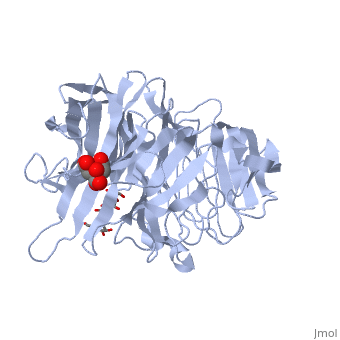1w2t
From Proteopedia
beta-fructosidase from Thermotoga maritima in complex with raffinose
Structural highlights
FunctionBFRA_THEMA Hydrolysis of sucrose, raffinose, inulin and levan. Specific for the fructose moiety and the beta-anomeric configuration of the glycosidic linkages of its substrates. The enzyme released fructose from sucrose and raffinose, and the fructose polymer inulin is hydrolyzed quantitatively in an exo-type fashion. Evolutionary ConservationCheck, as determined by ConSurfDB. You may read the explanation of the method and the full data available from ConSurf. Publication Abstract from PubMedThermotoga maritima invertase (beta-fructosidase), a member of the glycoside hydrolase family GH-32, readily releases beta-D-fructose from sucrose, raffinose and fructan polymers such as inulin. These carbohydrates represent major carbon and energy sources for prokaryotes and eukaryotes. The invertase cleaves beta-fructopyranosidic linkages by a double-displacement mechanism, which involves a nucleophilic aspartate and a catalytic glutamic acid acting as a general acid/base. The three-dimensional structure of invertase shows a bimodular enzyme with a five bladed beta-propeller catalytic domain linked to a beta-sandwich of unknown function. In the present study we report the crystal structure of the inactivated invertase in interaction with the natural substrate molecule alpha-D-galactopyranosyl-(1,6)-alpha-D-glucopyranosyl-beta-D-fructofuranos ide (raffinose) at 1.87 A (1 A=0.1 nm) resolution. The structural analysis of the complex reveals the presence of three binding-subsites, which explains why T. maritima invertase exhibits a higher affinity for raffinose than sucrose, but a lower catalytic efficiency with raffinose as substrate than with sucrose. Crystal structure of inactivated Thermotoga maritima invertase in complex with the trisaccharide substrate raffinose.,Alberto F, Jordi E, Henrissat B, Czjzek M Biochem J. 2006 May 1;395(3):457-62. PMID:16411890[1] From MEDLINE®/PubMed®, a database of the U.S. National Library of Medicine. See AlsoReferences
| ||||||||||||||||||||


